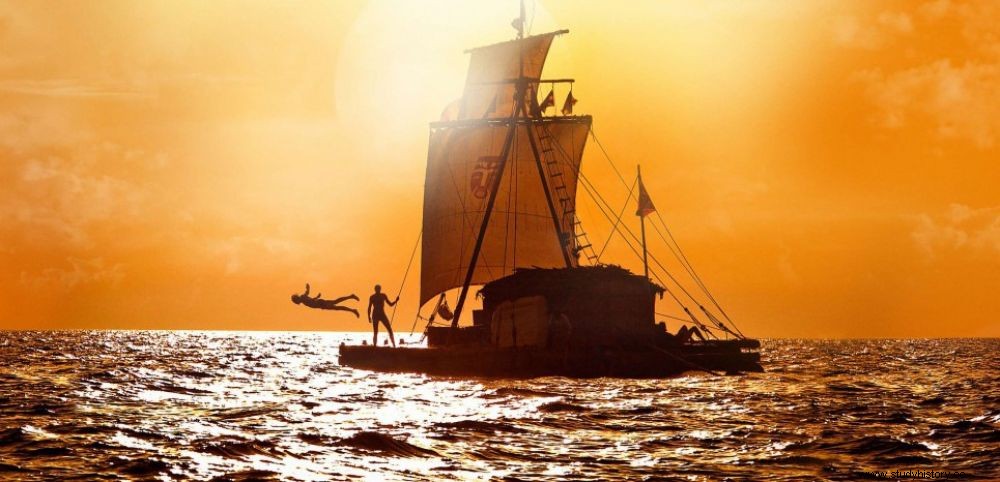 A still from the 2013 Oscar nominated Norwegian film Kon-Tiki.
A still from the 2013 Oscar nominated Norwegian film Kon-Tiki. On April 28, 1947, six intrepid navigators – five Norwegians and one Swede – left Callao, Peru, aboard a 14-meter-long raft, the Kon-Tiki. Their goal is to complete a journey of 7,000 kilometers across the Pacific Ocean. At the time, unheard of. Although certain death is predicted for them, the six sailors do not hesitate to brave the ocean after taking their place on a balsa skiff built by their own hands, "without nails, rivets or wire " . The craft is believed to be an exact replica of the rafts used by the ancient Incas. At the head of the expedition, a Norwegian naturalist named Thor Heyerdahl. On August 7, 1947, a hundred days later, the Scandinavian sailors reached, not without difficulty, the atoll of Raroia (Raro-Nuku) in the Tuamotou archipelago. The enthusiasm aroused by the feat is immediate. The whole world acclaims the heroes. The sporting achievement is celebrated but the expedition is much more than a daring crossing.
An experimental navigation to prove that it was within reach of the Incas!
Because it was during a stay on the island of Fatu Hiva, in the Marquesas archipelago, ten years earlier, that Thor Heyerdahl, then a zoologist specializing in marine invertebrates, developed an incredible theory. In Fatu Hiva, he regularly meets an old man, Tëi Tatua, who tells him strange legends. Tiki, the leader of his ancestors, would have led them to these islands. Going through ancient Peruvian chronicles, Heyerdahl believes he discovers that the name of the Andean god Kon Ticsi Huiracocha is the same as that of the god Tiki, venerated by the Polynesian islanders. Also, every evening, looking at the ocean, the naturalist tells himself that less than 8,000 kilometers away are the coasts of South America... He is convinced that Oceania was originally populated by men coming from those distant shores to the east.
This theory will be developed in his bestseller translated into more than 60 languages The Kon-Tiki Expedition . Almost 70 years later, what remains of the Kon-Tiki ? An undeniable feat coupled with a demonstration of the Norwegian's intuition. Yes, westward travel on the high seas from South America was possible, even in flimsy craft. And the Incas were indeed able to reach certain islands of Oceania by raft. Thor Heyerdahl died in 2002 at the age of 87.
READ ALSO.
The Incas practiced surgery without a scalpel. In the 16th century, the practice of ritual cannibalism and human sacrifice provided the Incas with unparalleled surgical knowledge.
Children of the clouds. In 2013, 35 new sarcophagi of the Chachapoyas - a civilization conquered by the Incas - were discovered in the Peruvian Amazon.
The Kon-Tiki Odyssey. In 1947, 7000 kilometers on the Pacific in a raft for an experimental navigation intended to prove that the feat was within reach of the Incas.
